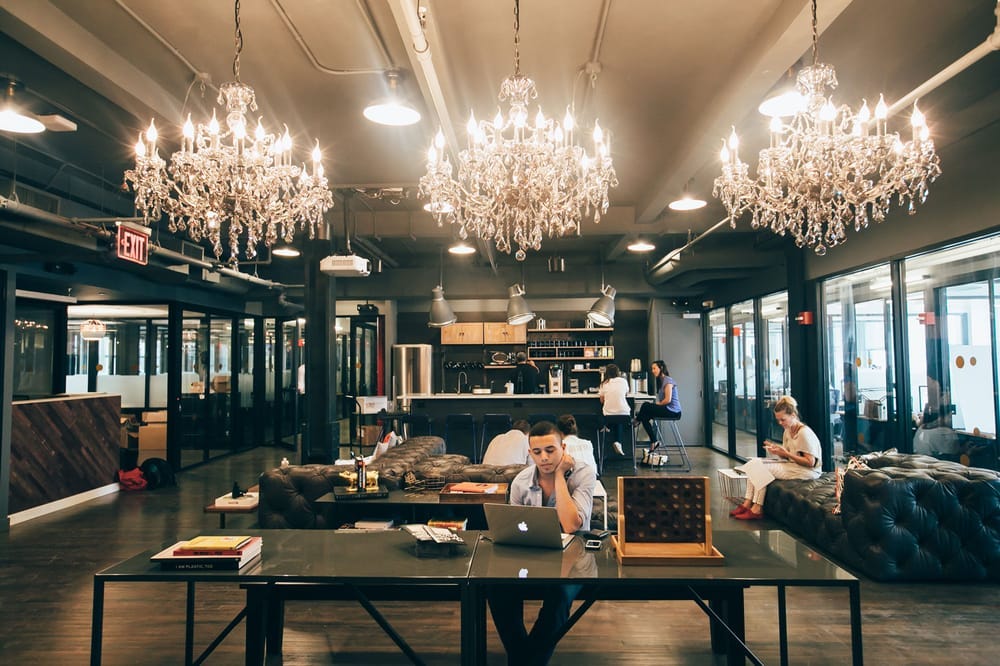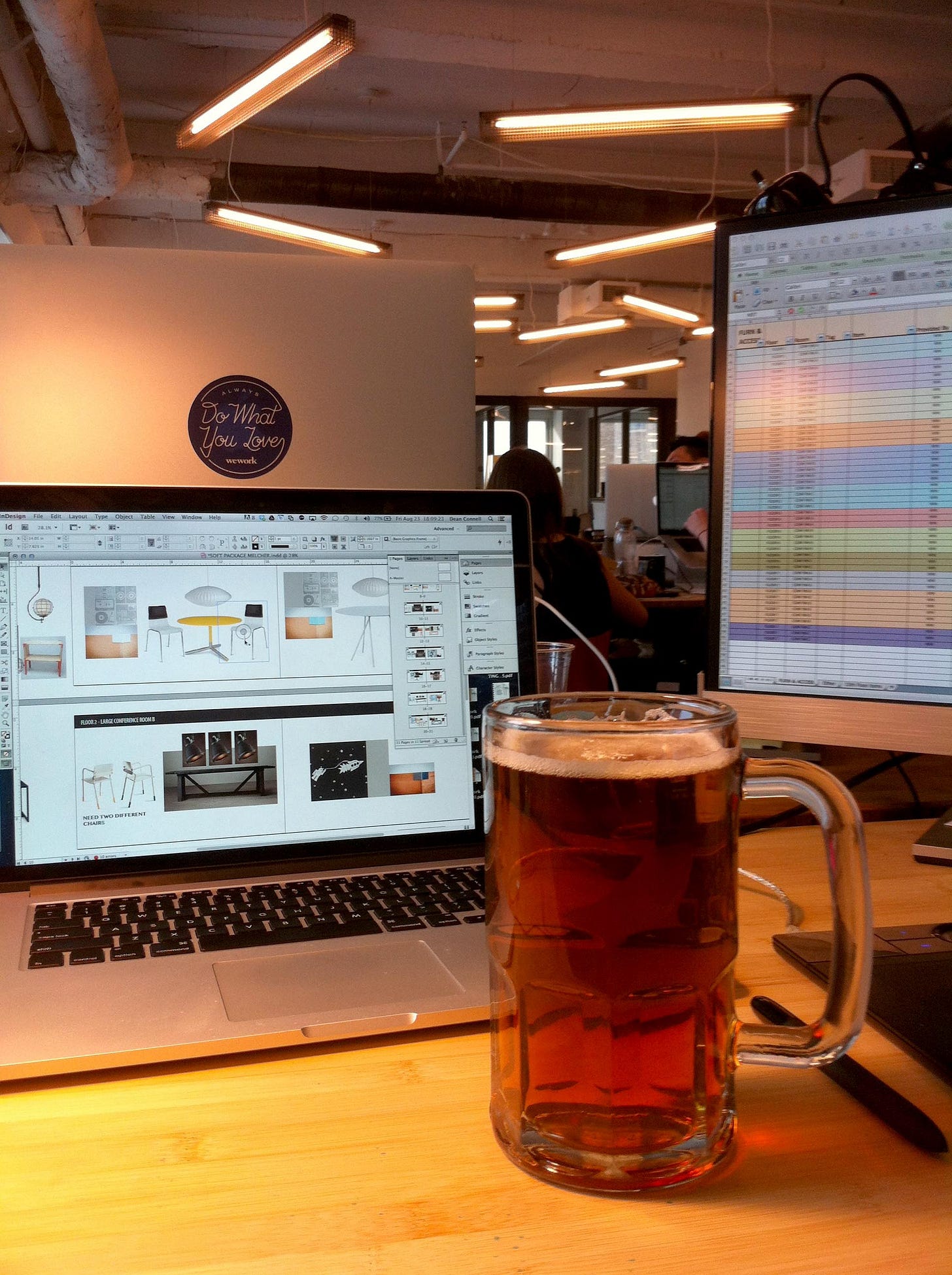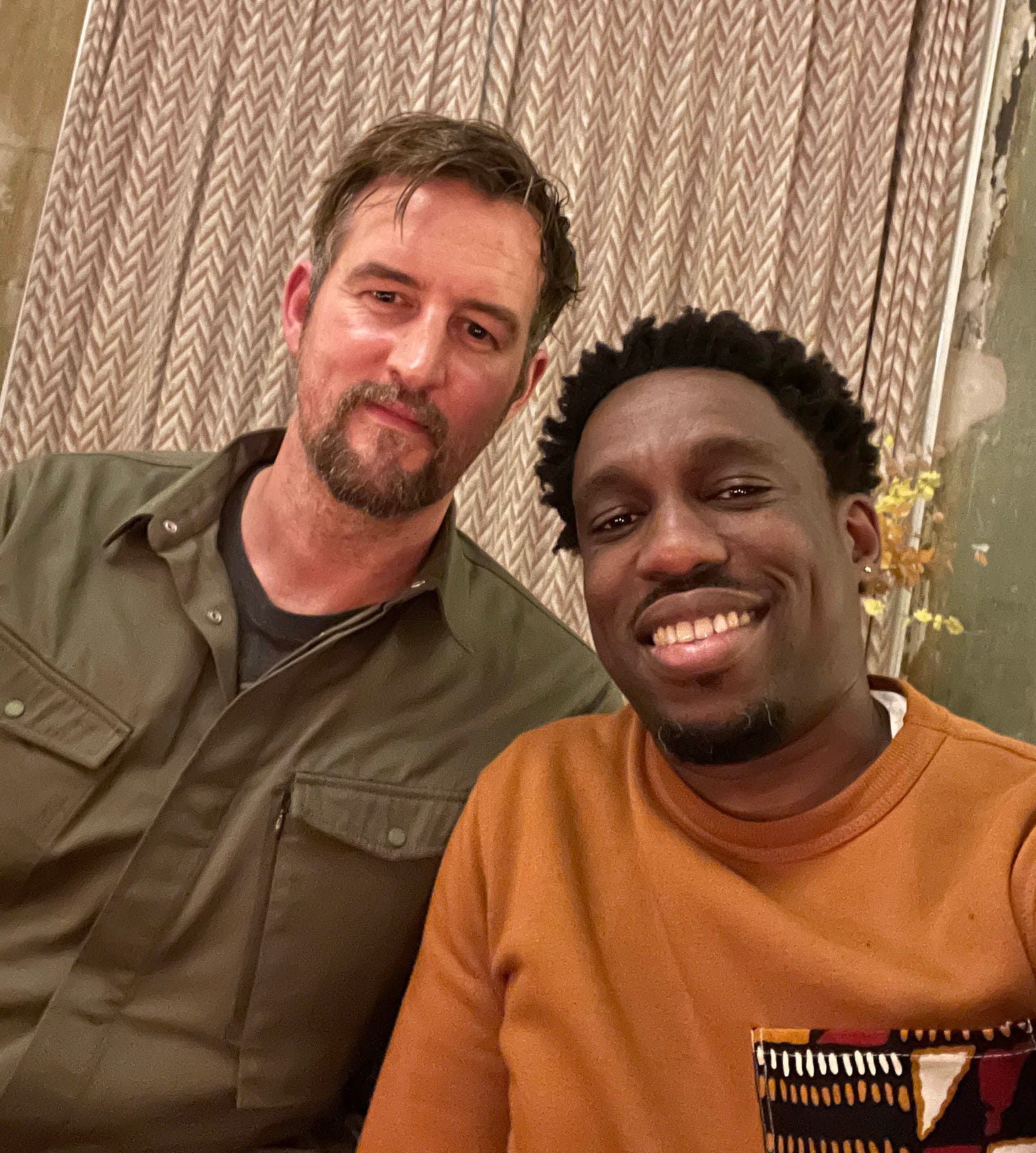We'll figure it out
Four words that started my journey into workspace design and became part of my life philosophy.
Twelve years ago, on a British bank holiday Monday in May, my agency design career ended
Time folded in on itself
Over the bank holiday weekend in 2013
In just my seventh year as a professional
My life changed
I had completed a cycle
Climbing the ladder
In pursuit of seniority
A holiday weekend that wasn't a holiday at all
Just open-ended possibility
That quickly became a glorious opportunity
That started with a statement:
"Marry your girlfriend"
Landed in New York: A cuddle, an Interview and possibilities
Those three words, 'marry your girlfriend', felt so foreign to me at the time
But to understand how and why these words were uttered
Let me take you back to where it all began -
May 2nd, 2013:
A Thursday.
I arrived in New York.
To visit my long-term girlfriend, Jess.
Who was working for a marketing agency on an L2 visa.
I arrived late that evening.
As we cuddled up in bed, she asked me,
"What will you do tomorrow while I'm at work?"
I said nonchalantly:
"I have an interview."
"Wait, what!" she exclaimed.
"Yeah, I've been talking to this guy Devin via email for a few days.
He works for this workspace startup, WeWork and agreed to meet me tomorrow."
"Wow! That's cool," she said, and we went to sleep.
The next day, I arrived at 175 Varick Street and was greeted specifically by
, who has since become a long-time friend.He directed me to the second floor
The elevator doors opened to reveal a different world:
dark and moody,
walls painted charcoal grey,
and music playing.
It felt like crossing a threshold.
I half expected corporate predictability.
Instead, I walked into creative possibility.
I walked directly into a lounge and kitchen area.
Like I had just arrived in someone's cool apartment.
It was not a typical office, and it didn't feel like one.
First impressions always matter
Sure, you can check out a place online before you visit, which is what I did.
But, when it comes to Interiors, you must experience it to truly get a 'feel' for a space.
Creating the right vibe might sound like fluffy design speak.
But I can assure you that if you want to build something memorable, the customer journey and experience in the best places are essentially ‘curated’, by design.
Let me break down my entry experience into tactical moments:
The Human connection: I entered and was greeted by a person who was amenable and solely focused on me.
This wasn't reception; it was ritual.
In that moment, Johnson wasn't just welcoming a visitor;
He was initiating someone into a new way of thinking about work.
I felt comfortable, in the right place, and clear on what I needed to do next.
Autonomy and trust: I was told to head to the 2nd floor, and Devin will meet you there. “Just wait in the lounge and help yourself to coffee and water.”
I was immediately treated like I belonged.
I was trusted and introduced to a key component of the brand's operation: the self-serve kitchen pantry area, the centre of gravity.
Subtly, this tactic meant I would have:
Time to acclimate: Now I could psychologically adapt to the change in a new environment and form those first impressions.
You commit to memory core elements of the space that interest you...
- The comfy furniture, the bicycle prop, and the secret door with library book wallpaper.
The first conversation behind glass walls and a core design principle revealed
I sat waiting, absorbing all the details, keeping my eye on the library wallpaper,
half expecting Devin to arrive through the secret door.
Instead, he appeared through a wall of glass.
He was warm and relaxed, leading me down a long hallway toward a conference room.
On either side: sliding glass doors, transparent offices. No visual privacy.
I was shocked - then he explained the concept:
People sublease these private offices on flexible monthly contracts,
accessing shared lounges, meeting rooms, and other services.
I still couldn't grasp all the glass...
"Do people care that it's all open like this?"
He said two things that have stuck with me ever since:
It's open because it breaks down barriers between people. Imagine getting up from your desk daily and looking into someone else's office. Sooner or later, you guys will talk."
It's part of our brand expression - to foster community and togetherness. Many of these companies are start-ups and find it useful that there are people like them who could help across the hallway.
Two profound insights emerged:
First, physical transparency breeds human connection. When you see your neighbours working, they stop being strangers and become potential collaborators.
Second, the visual aesthetic exists to encourage connection. Like the craftsman's philosophy that the workshop itself tells a story, the glass offices became the brand's core identity.
We chatted for about an hour. We discussed my experience, design, and life, and I learned more about the company.
From memory, we spent most of the time talking about music. Both Devin and I shared a passion for music production and DJing.
We could've chatted for hours, but conscious of time, Devin said:
"I have another meeting:
But, you should meet Miguel"
Something in his tone suggested this wasn't optional. This was progression.
He left the room, and I began preparing what I would say to Miguel when they returned.
I was nervous.
But Devin came back alone and said:
"He can't meet right now. Is there any chance you can come back on Monday?"
Lucky for me, the flight back to London wasn't until Tuesday.
"Yeah, sure", I said.
The Bank Holiday opportunity, but can you start next week?
Monday, May 6th, 2013 - A Bank Holiday in the UK.
My final day in New York before heading home.
I returned to Varick Street that morning with a mixture of anticipation and anxiety, my portfolio tight under my arm, ready for whatever this meeting might bring.
Maybe it was the nerves, but everything felt different, quieter and more purposeful.
I sat waiting in a different conference room.
Then, after arriving a few minutes later, Miguel McKelvey appeared.
Basketball size in height, but just like my experience with Devin, he seemed calm and down-to-earth.
Usually, in all my interviews before this, I felt pressure to impress with rehearsed answers to typical questions about my work, like:
"What did you learn from this project?", etc.
Not this meeting.
It was a genuine conversation about my experience and attitude towards design.
I felt completely comfortable just being myself.
Miguel flicked through my portfolio, then - a curated A4 (11 x 8.5") sized bound book, titled:
The story so far, volume two
And then he paused and put the book down as if he had seen enough.
"Your work is cool", he said
He explained that they had two new projects in Boston that needed designing and were falling a little behind schedule.
"I think you would be a great fit."
"But we need you to start in a week or so."
His directness took me aback.
No, we'll contact you in a few days after we deliberate.
It was straight to the point and something I would come to love about the company.
Then came my reply:
“How will it work? I don’t have a visa.”
Miguel picked up his phone and began texting furiously.
The room went dead silent for about 20 seconds. I could hear my own breathing as he paused and said,
"We'll figure it out"
4 words that became synonymous with this start-up. An optimism mixed with vulnerability. It encapsulates a spirit that has become an integral part of my designer tool-kit.
Now, I approach any new project with that same spirit:
To be enterprising and resourceful in solving problems. No reliance on playbooks or defined corporate guidelines. A willingness to try different things to find the right solution.
To be honest enough to admit you don't know something. This is how you grow because that humility will enable you to ask the right questions.
About five minutes had passed, which felt like an eternity. During that time, I told Miguel that I was travelling back to the UK and hoped we could find a way to make it all work.
Then the room door opened and in came Stella, an executive assistant and trained Immigration lawyer.
She sat down and listened to me share my circumstances.
Then said quite candidly:
“Marry your girlfriend.”
I was completely caught off guard and replied,
“Whoa, too soon. There must be another way?”
I spent the next few minutes feeling stressed, like this was my opportunity slipping away.
Miguel sensed the heightened anxiety and repeated those soothing words that let me know I hadn't scuppered my chances.
"Don't worry. We'll look into some other options and figure it out this week."
Back to reality, a trade-off and a leap of faith
Tuesday, May 7th, 2013.
I flew back to London with a tumbler of emotions
On the surface, I was excited yet dancing with worry inside.
I'd come this far, and the thought of it fizzling out felt unbearable.
Yet, Miguel's words echoed: "We'll figure it out."
Over the next few days, text messages flew back and forth across the Atlantic.
Solutions emerged, then dissolved.
Finally, clarity: I could work as a consultant and travel to the US, limited to 90 days.
It was imperfect. It was uncertain. It was everything.
I quit my senior design job and thought, if I only have three months, then I should make the most of it.
I incorporated IAMDC Ltd.
My design consultancy and passion for workspace design were born out of necessity and desire for a new experience.
It just felt right.
By month's end, I was back at 175 Varick Street.
A beer sat on my desk, racking my brain over...
Feet & Inches, furniture specs and move-in packages.
Everything is measured differently here.
I felt like a novice again.
This wasn't the next career step I'd imagined when I climbed the agency ladder.
This was a leap of faith with no pension.
Exhilarating, terrifying, transformative.
Twelve years on, today, I don't see constraints, I see opportunities
As I reflect on my journey, designing my first coworking space in Boston.
I realised Miguel was right all along.
We had figured it out.
And in doing so, I'd figured out something essential:
The best opportunities don't follow scripts.
They demand we write new ones.
Back then, I arrived in New York hopeful but without expectations.
After the long weekend, I left with a sense of urgency: Even though the future was uncertain, this was an opportunity I couldn't pass up.
So, as I share my experience, share insights on workplace strategy, and explain my design philosophy in these newsletters, I feel the same excited yet worried feeling.
But,
"We'll figure it out" has become more than just a mantra,
It's a methodology for approaching new and uncertain paths.
That's the secret I've carried through every project since:
When faced with constraints, I don't see limitations.
I see a chance to be creative.
Like those glass-walled offices I first encountered with Devin, where transparency breeds connection.
My work in progress is an open journal where ideas flow freely.
I want to be that transparent companion on the other side of the glass.
Your workspace challenges might feel impossible today.
But remember: possibility often arrives wearing the costume of a problem.
The question isn't whether you can solve it.
The question is: Are you ready to figure it out?
I-AM Dean Connell.
Thanks for reading.












Enjoyed this, thanks for sharing Dean!
This was such an inspiring read and a reminder that unconventional paths often lead to the most meaningful work